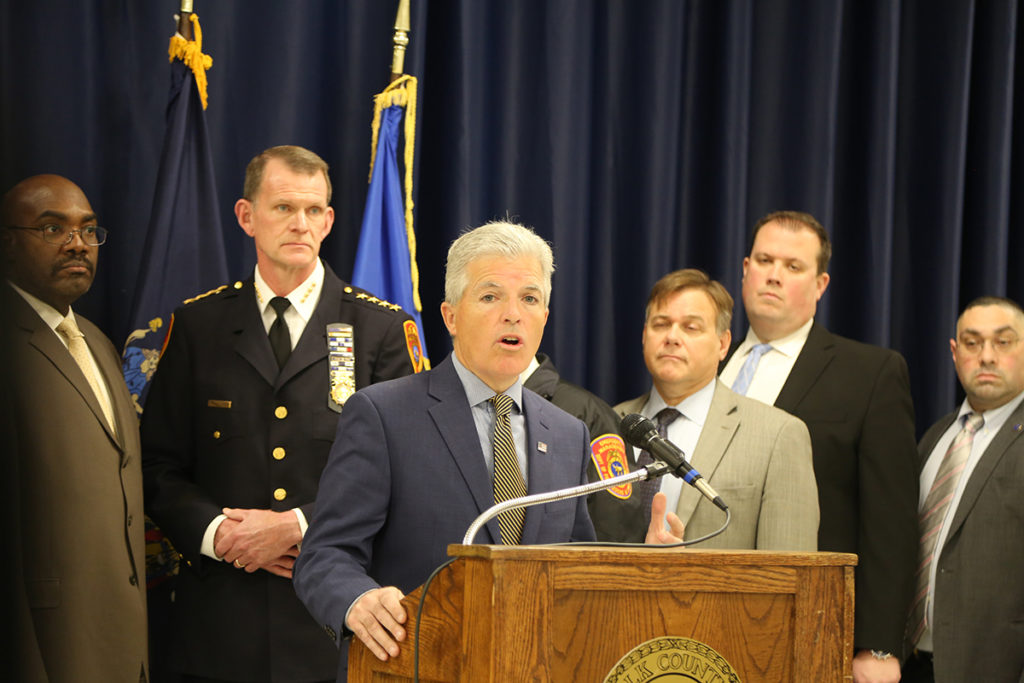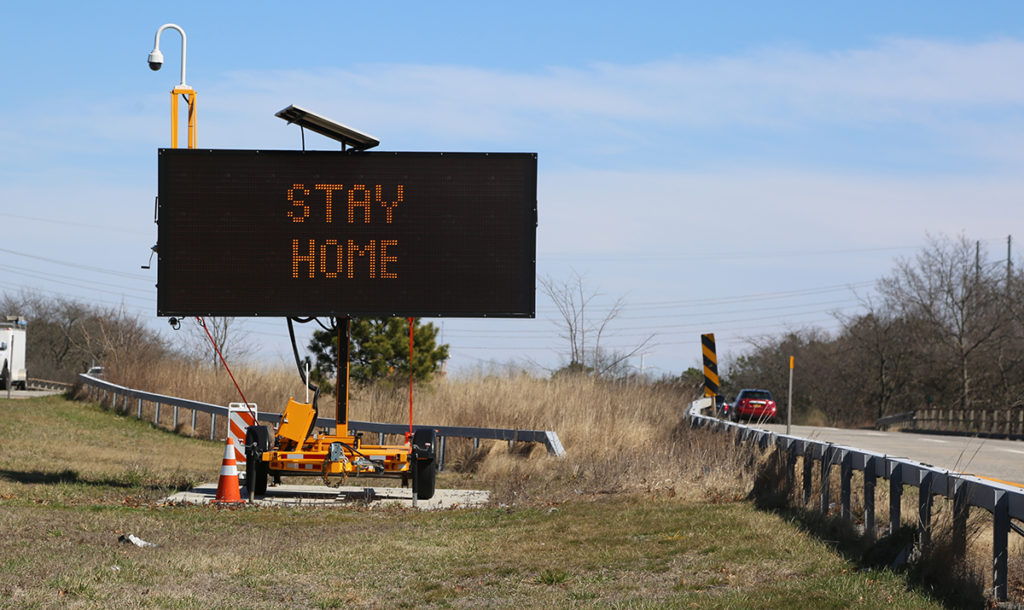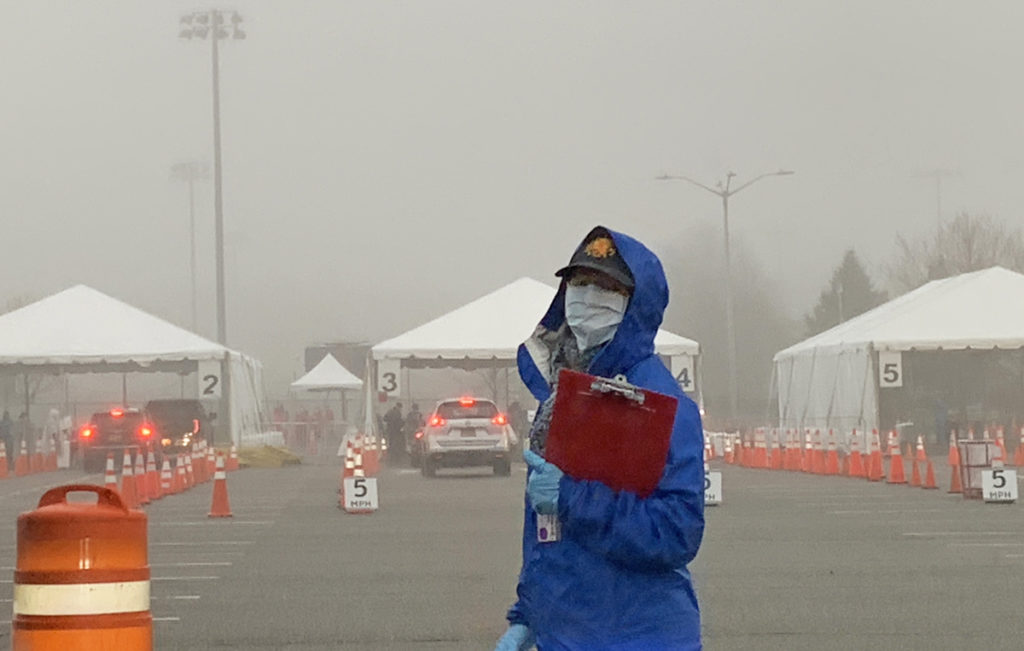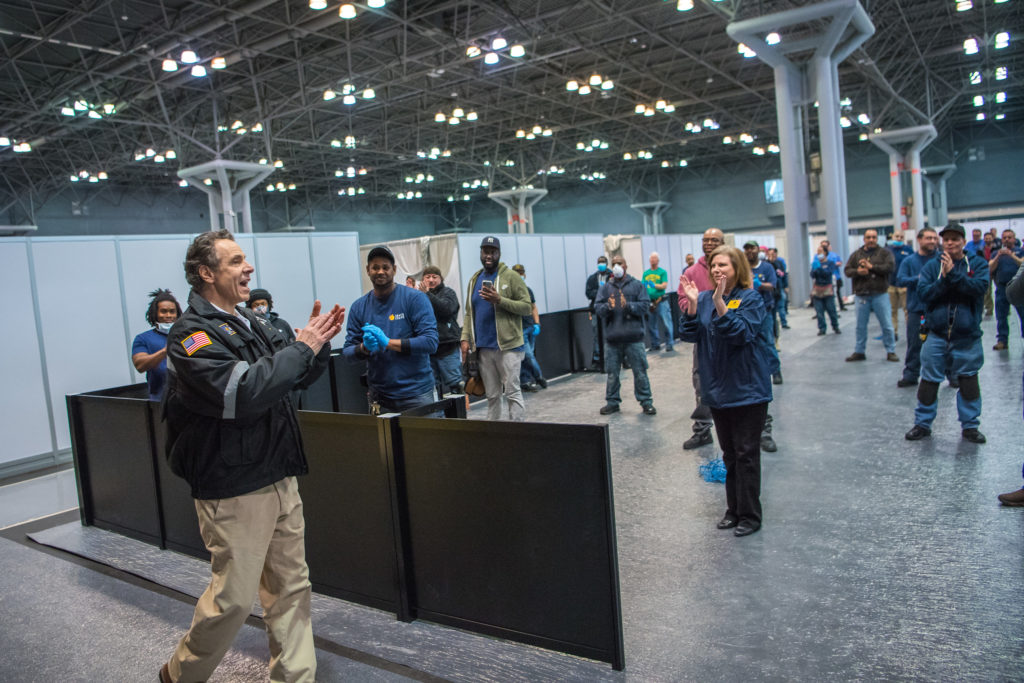One month later: The coronavirus has shut down Suffolk County, infected thousands of its residents and killed the most vulnerable

Standing side by side, nearly a dozen of Suffolk County’s top public safety officials appeared before the media March 9.
A press officer briefly inspected them from the other side of the podium, envisioning how they might be framed on the cameras behind him. Seeing a small space between the county’s health commissioner, who had been appointed to his new role just six days earlier, and the chief of police facing him, the spokesperson gestured for the two men to close the gap.
“Dr. [Gregson] Pigott, if you guys could just take one step closer,” he said.
“Don’t breathe on each other,” joked a photographer there to capture Suffolk County Executive Steve Bellone’s remarks that transformative day.
Looking back now at a media briefing with county leaders prior to calls for social distancing serves as a reminder of just how much things have changed in one month.

The officials had gathered that morning so Mr. Bellone could formally announce Suffolk’s first confirmed case of the coronavirus.
“The patient, a male in his early 40s, remains in hospital isolation,” he said. “Suffolk County communicable disease professionals have begun a thorough investigation into the patient’s contacts as it believes the person in this case contacted the virus through community transmission. So far the department has identified one individual who has been in close contact with this confirmed patient. The individual will remain in mandatory quarantine to help prevent and contain the spread of the virus.”
The county executive would go on that Monday morning to outline steps the county had taken to prepare for the possibility of COVID-19 arriving here, including an inventory of personal protective equipment, daily check-ins with the Centers for Disease Control and Prevention, and a day of training for employees.
“We’re focused on education to assure residents that, again, there is no reason for alarm,” Mr. Bellone continued.

Now, exactly one month later, our county, state and country are unrecognizable in many ways as we continue to quarantine. Nonessential businesses — and our school buildings before them — have been closed for weeks. The number of confirmed cases has risen above 15,000. Suffolk’s death toll stands at 263. And in Southold Town, where county Patient No. 1 lives, nearly 10 in every 1,000 residents has tested positive for the virus.
A woman in her 20s later identified as the person who had been in close contact with Suffolk’s first case would test positive a day after Mr. Bellone’s first press conference. Five days earlier, she was behind the wheel when the man took a cab to the hospital. The following day, she worked four hours at her other job at Peconic Landing, a Greenport life care and retirement community, where she, 14 colleagues and 18 members have since been confirmed to have the coronavirus.
What we’ve learned from testing
Suffolk County’s first two suspected cases of the coronavirus produced negative test results on Wednesday, March 4, according to data released by the New York State Department of Health. Over the course of the next three days, five additional COVID-19 tests came back negative, before the first confirmed case on March 8.
One month later, 33,225 Suffolk residents have been tested for the coronavirus with 15,561 receiving a positive diagnosis. At 43.7%, Suffolk has produced a higher percentage of positive results than all but two of the state’s counties outside of New York City and has more cases than all but six other states.
TRACK STATE DATA
At his March 9 press conference, Mr. Bellone said testing at hospitals in New York State was “still limited” and that people feeling symptoms should not expect to be tested.
“Quite frankly that’s not where we are in terms of testing capacity at this point,” he told reporters.

It would take more than two weeks — with the opening of a mobile site at Stony Brook University — for the county to increase testing. Nearly 1,500 county residents were tested on March 20, almost doubling the number of tests given in the previous 15 days. In the 18 days since, the county has averaged testing more than 1,650 individuals a day.
While data from the first two weeks of testing shows only one in every 5.6 residents tested positive, that number has increased to one in every 2.29 patients since the Stony Brook site opened.
Suffolk hit its peak for number of tests given in a single day when 2,575 were completed on Thursday, April 2. The 1,408 new confirmed cases that day also marked a high.
Data released by the state health department shows 138,863 residents across New York have tested positive for the coronavirus. About 55% of the total cases are men. That number jumps to 61% when analyzing the state’s 5,489 fatalities. Of the total number of COVID-19 deaths in New York, 86% had pre-existing conditions, with hypertension and diabetes among the leading comorbidities.
About half the state’s COVID-19 deaths were patients between the age of 70 and 90, though the virus has killed more than 325 New York residents under the age of 50. Four children aged 10 to 19 with no known pre-existing conditions have also lost their lives and the state’s first child under 10 was reported to have died Tuesday, state records show.
SUFFOLK COUNTY COVID-19 MAP
Suffolk County stopped providing breakdowns of its fatalities by age, gender or hamlet this week. Mr. Bellone said that was to free up front line workers from having to report as much information.
Before the change in policy, the youngest reported deaths in the county were men in their 30s.
The 731 new fatalities in New York State and 64 reported in Suffolk Tuesday, marked the highest single day COVID-19 death toll for both.
“I guess one could get numb to the numbers,” Mr. Cuomo responded on Tuesday to a question about people becoming desensitized to the death toll. “But you have to remember every number there’s a human being behind that and a family … The hospital staff that goes through this they’re not getting numb. The families who lose loved ones aren’t getting numb.
“You can’t save everyone,” he continued. “This virus is very good at what it does and it kills vulnerable people.”
Have we hit the apex?
For as much as the alarm bell appeared to be sounding at the start of the weekend, by Sunday state and county officials had begun to speculate that the curve was beginning to flatten.
“We won’t know until we see the next few days,” Mr. Cuomo said Sunday.
He said the different models the state looks at all show numbers going up until an eventual apex, at which point cases will start to decline. But what’s unclear is whether there is a plateau at the top of the apex, where the numbers remain steady for a certain time period before the drop-off starts, he said.
“We’re all feeling our way through this and we have the best minds in the country advising us because New York is the first,” he said.

Statisticians analyzing data on the coronavirus haven’t offered any specific predictions. He said they need more data in the next few days to determine whether there is a plateau.
“I hope we’re somewhere near the apex or we’re somewhere near the plateau,” he said when referring to the highest projections for number of hospital beds the state may need.
Suffolk County Executive Steve Bellone — who reported just 26 new hospitalizations in Suffolk County, including six in intensive care Monday — echoed the governor in saying we still need to see more data before declaring it the apex.
“If this is in fact that we are at an apex or we have reached that plateau, it’s because of social distancing,” Mr. Bellone said.
Since the beginning, county officials have stressed the importance of keeping the hospitalization rate low. The governor in mid-March mandated that all New York hospitals grow their number of beds by a minimum of 50% and progress was made locally this week with hospitals like Stony Brook Southampton, which is handling all intensive care cases out of Stony Brook Eastern Long Island Hospital in Greenport, doubling its total beds and tripling its ICU capacity.
With a countywide expansion and the combination of a growing number of deaths and an increase in patients leaving the hospital — 240 were discharged between Sunday and Tuesday — Suffolk County is now somewhat better equipped to handle the demand.
There are currently 3,215 hospital beds and 710 ICU beds in Suffolk County. About half of all beds are available, but just under 25% of intensive care units are open, the county reported. The total number of hospitalized patients has remained relatively flat since Saturday after several days of steep growth — though a slight bump was reported Tuesday.
It’s the hospitalization apex, Mr. Cuomo has stressed, that will ultimately turn New York toward safety as the fight is about keeping people alive. The governor, who said 802 ventilators were sent to hospitals across the state Monday, believes the biggest current need is to continue to acquire more respiratory systems. Personal protective equipment also remains in short supply in Suffolk County, but Congressman Lee Zeldin (R-Shirley) and President Donald Trump secured 200,000 N95 masks and 150,000 ear-loop masks this week. The county said its stockpile was empty prior to the supplies being secured.
State and county officials have so far declined to declare this an official apex and have instead stressed the importance of maintaining social distance.
“Remember this is a projection, it still matters what we do,” Mr. Cuomo said Tuesday.
To that end, schools and nonessential businesses across New York State will remain closed through at least April 29 and state education officials canceled June’s Regents exams.
The governor also said he has doubled the maximum fine for social distancing violations from $500 to $1,000, though Suffolk County officials said no violations have been issued here.
Mr. Cuomo is calling the next phase of the state’s battle with COVID-19 “restarting life.” It starts with testing, he said, noting that rapid testing needs to be brought to scale and that the state is also awaiting Federal Drug Administration approval on antibody testing that could allow individuals who were positively diagnosed with and have recovered from the coronavirus to return to the outside world. He suggested Tuesday that those state residents could even return to work sooner than others.
The governor also said he believes more stimulus money will be needed to help New York financially recover. He said on Tuesday that he was writing to all the state’s federal representatives to find solutions in future legislation.
Mr. Bellone said Tuesday that however New York decides to move forward, the health and safety of front line workers remains a top priority.
“Our health care workers are still under enormous pressure and that will remain for some time,” he said.
Recommended reads
- Pastor Alvin Charles McElroy, 79, a pillar of Flanders community, dies of coronavirus
- Long Island Aquarium faces its greatest crisis
- Shelter Island nurse tells her story from the front lines of the pandemic
- FAQ: Breaking down many of the questions surrounding coronavirus
- How to Help: A listing of fundraising efforts underway for groups in need








